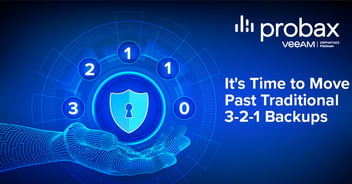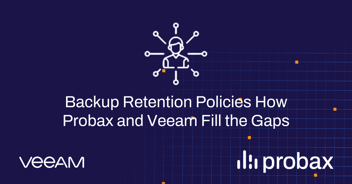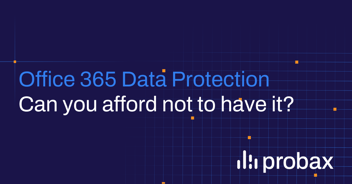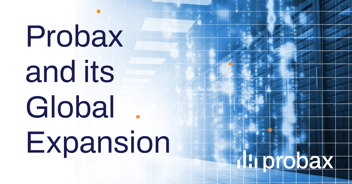A robust disaster recovery strategy is one of the key assets for maintaining business continuity. With increased reliance on cloud storage systems, protecting your data and its backups from cybersecurity threats has become a necessity to reduce downtime and avoid process disruption.
The Cost of Downtime
According to ITIC's 2021 Hourly Cost of Downtime survey, one hour of downtime results in an average loss of $300,000+ per hour for mid and large-sized enterprises. Downtime can result in severe consequences, including lost business, disrupted customer trust, and failure.
Regardless of the type of cyberattack, keeping your data backed up in real-time is crucial to recover from disasters effectively. The problem is that maintaining on-site data backups can be costly. It’ll significantly take away from your resources and put a heavy load on your IT department.
Therefore, adopting a third-party backup and recovery solution is your best bet. Such a solution should be capable of identifying protection gaps to allow for quick actions to be implemented.
Downtime from accidental technology failure is inevitable, and in most cases, there’s not much you can do about it. What you can do is fortress your systems to protect your business from malicious users and cyber criminals.
Many businesses now rely on multiple data storage and backup infrastructure that include cloud, on-premises, endpoint, and SaaS systems, resulting in an increased attack surface for hackers. A single vulnerability from a configuration issue presents an opportunity for cyber threats to jeopardize your business.
Setting Your RPO and RTO
Understanding the difference between RPO and RTO is crucial for effective disaster recovery planning.
RPO (Recovery Point Objective) is the highest tolerable amount of lost data in a disaster that won’t impact your business significantly. On the other hand, RTO (Recovery Time Objective) is the time duration your business process can hold up until it’s fully restored.
The RPO and RTO values are unique for each business. You must calculate these two vital metrics in your disaster recovery planning to develop a solid strategy that you can rely on to maintain business continuity.
Developing a Disaster Recovery Strategy: The Fundamentals
According to Veeam's 2022 Data Protection Report, three out of four surveyed organizations have suffered at least one ransomware attack with up to a third of affected data typically unrecoverable. This indicates that developing multi-layered cybersecurity measures is no longer optional.
Being able to identify zero-day cybersecurity threats in your backups can significantly contribute to preventing downtime due to ransomware encryption.
If you’re already using a specific malware detection software to protect your primary data location, it’s not a good practice to incorporate the same solution for your backup location(s). These software detection solutions identify threats by checking for identical signatures, which is often not enough to detect all malicious files.
Things get more complicated if the malicious files exist in both your primary and backup data locations since the software won’t perform its intended function twice, not once. This also means you won’t be able to use your backup to recover data in case of emergencies.
Whether you rely on SaaS, cloud, or on-premises solutions to store your data, full protection isn’t always guaranteed. You must have a plan B, consisting of a backup strategy that also provides an extra layer of protection.
Further, adopting an AI-powered solution to detect cybersecurity threats in your backups provides a higher level of protection for your data while presenting an additional opportunity to detect ransomware before it’s too late.
Building a Backup Strategy for Data Recovery
Ensuring your data is fully recoverable in unexpected situations is essential to retain it and prevent it from being lost. There are multiple backup strategies that you can implement, either separately or collectively, to protect your data, which include:
Air Gap
An Air Gap DR strategy encompasses separating the primary and backup storage systems physically. This simple procedure guarantees malicious users won’t be able to breach the backed-up copies.
3-2-1-1-0 Strategy
To follow the 3-2-1-1-0 strategy, you should back up your data as follows:
- You should have three separate copies of data
- These data copies should be stored in two different forms of media
- One of these media copies should be off-site
- One copy of your data has to be immutable, offline, or air-gapped
- You should make sure there are zero errors with backup testing and recoverability verification.
Creating multiple data backups in different locations provides extra protection and recoverability. If you have a copy that is offline or immutable, then your data can still be recovered in the event of a ransomware attack. You also must make sure there are no surprises when you backup your data.
Malware Identification and Elimination
Ransomware doesn’t attempt to breach encrypted systems once it gains access to the network. Instead, it remains idle until it propagates to all backup versions to guarantee a successful ransomware attack.
As a result, having the resources to detect and remove ransomware has become crucial. Building an isolated location for data recovery is essential too.
Flexible Recovery
Downtime can significantly impact your productivity and business continuity, potentially causing severe financial losses. Ensuring that data is recoverable quickly is essential when creating a backup strategy.
Ideally, your system should allow temporary access to key data based on their priority level. Vital data must be ready for recovery to get your systems back online quickly.
Other Disaster Recovery Considerations
Since cloud backups are your last resort when you need to recover your data quickly, you must test your backup systems to ensure they’re working as intended.
Ideally, your DR solution should provide immediate access to your data by enabling streaming on demand for critical files to keep your business running while recovering the remaining data in the background.
That said, here are a few factors to take into consideration for your disaster recovery planning:
Adopt a cloud-based backup and recovery solution.
Cloud-based solutions save you the costs of setting up and maintaining multiple data centers and costly infrastructure.Make access to critical data instant.
Ensure that your backups are available to access temporarily in the form of a virtual drive and permanently to a specified location.Continue refining your DR strategy.
Regularly tweak your DR strategy to avoid disruption and maximize your operational response.
Conclusion
To recap, adopting a disaster recovery strategy is your best last line of defense against cyberattacks.
Separating primary and backup locations physically and setting up an isolated location for data recovery are excellent tactics for developing a sustainable disaster recovery strategy.
Ensuring your critical data can be accessed and retrieved quickly in case of disasters is essential to maintain business continuity as well.
Offering a modern backup and recovery DRaaS (Disaster Recovery as a Service) solution that supports data streaming and provides AI malware detection and removal is a guaranteed technique to keep your MSP clients’ data safe and recoverable in unexpected situations.
You need DRaaS in your MSP toolkit
Traditional backup only protects a segment of data. That's why our practical and free white paper Most MSPs Have Inadequate Disaster Recovery Solutions outlines everything your MSP needs to know about the importance of DRaaS.
Simply click below to download your copy today!






